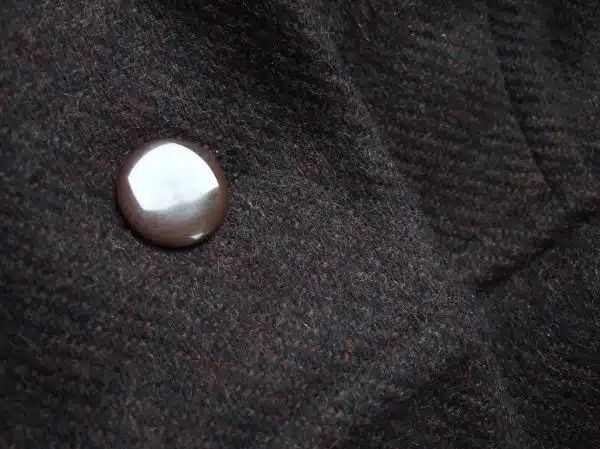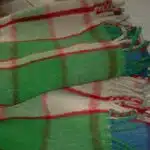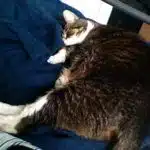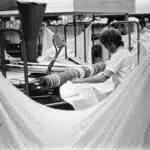As professional dry cleaners, we understand the importance of proper care for all types of clothing. One item that often requires special attention is a wool coat. Many people assume that wool coats must be dry cleaned, but this is not always the case. In fact, with the right technique and care, it is possible to wash a wool coat at home without causing damage to the fabric.
In this article, we will provide step-by-step instructions on how to properly wash a wool coat that is not labeled as “dry clean only.” We will discuss the materials needed for the process, as well as tips for avoiding common mistakes. By following our guidelines, you can ensure that your wool coat remains in excellent condition while also saving money on expensive dry cleaning bills.
Understanding Wool Fabric
As a professional dry cleaner, it is essential to know the intricacies of wool fabric. Wool is a natural fiber that comes from sheep and is widely used in making various clothing items such as coats, jackets, and sweaters. Understanding wool texture is crucial in caring for your wool coat. Wool has a unique texture that requires extra care compared to other fabrics. The texture of wool is often described as soft, warm, and luxurious.
Identifying wool blends is also vital when caring for your wool coat. Wool blends are combinations of wool with other fibers such as cotton or polyester. Identifying the blend will help determine how to wash or clean your coat properly. For instance, if your coat contains a blend with cotton or polyester, it may be safe to use regular laundry detergent and machine wash it at home. However, some blends may require special attention and care.
It is important to note that not all wool coats are labelled ‘dry clean only.’ Some can be safely hand washed or machine washed at home if done correctly. In the next section, we will discuss how to assess the care label of your wool coat to determine the best washing method without damaging its texture or color.
Assessing The Coat’s Care Label
First and foremost, before attempting to wash a wool coat that is not labeled as “dry clean only,” it is important to assess the care label. The care label can provide valuable information on how to properly care for the garment. The label may contain instructions on washing, drying, ironing, or any other special requirements.
It is essential to understand the fabric characteristics of your wool coat before washing it. Wool is a delicate fabric that requires special attention when washing. It can shrink and lose its shape if not washed correctly. Wool coats are usually made from natural fibers that come from sheep, goats, or rabbits. Each type of wool has different characteristics, which should be taken into consideration when washing your coat.
To ensure proper care of your wool coat, here are some key points to consider:
- Check for any symbols or instructions on the care label.
- Determine the type of wool your coat is made from.
- Consider whether the coat has any embellishments such as buttons or zippers that may require special attention.
By assessing the care label and understanding the fabric characteristics of your wool coat, you can ensure a successful washing experience without damaging your garment. In the subsequent section, we will discuss how to prepare your coat for washing.
Preparing The Coat For Washing
- Before washing a wool coat, it is important to check the care label for washing instructions.
- When spot cleaning a wool coat, use a damp cloth and mild detergent and blot the stain.
- Before washing a wool coat, it is recommended to remove excess dirt and debris with a soft brush.
- It is important to read the care label before washing a wool coat to ensure the proper care and cleaning techniques are used.
- Spot cleaning a wool coat can help to prevent the need for a full washing, and it should be done with a damp cloth and mild detergent.
- Before washing a wool coat, it is important to remove any excess dirt or debris with a soft brush to prevent damage.
Checking Care Label
When it comes to washing a wool coat, the first step is to carefully check the care label. Understanding wool fabric and its common misconceptions is crucial for ensuring that the coat does not become damaged during washing. Contrary to popular belief, wool can be washed at home as long as certain precautions are taken. Wool coats are particularly beneficial for winter wear due to their insulating properties that provide warmth even in extreme temperatures.
One of the most common misconceptions about wool is that it cannot be washed and must always be dry cleaned. However, this is not necessarily true. Wool can be washed at home using cold water and a gentle detergent specifically designed for delicate fabrics. Checking the care label will provide valuable information regarding any specific care instructions for your particular wool coat.
The benefits of wool for winter coats cannot be overstated. Its natural insulating properties make it one of the warmest materials available, ensuring that you stay comfortable even in freezing temperatures. Additionally, wool is highly durable and can withstand years of wear when properly cared for. By taking the time to check the care label before washing your wool coat, you can ensure that it remains in excellent condition and continues to provide warmth and comfort throughout many winters to come.
Spot Cleaning
When it comes to preparing a wool coat for washing, spot cleaning is an essential step. Spot cleaning involves treating specific areas of the coat that have stains or dirt buildup without washing the entire garment. This process prevents pilling and other damage that can occur when wool is washed too frequently or aggressively. As a professional dry cleaner, I recommend spot cleaning as the first step to maintaining the quality and longevity of your wool coat.
To prevent pilling, it is crucial to avoid rubbing or scrubbing the wool vigorously. Instead, use a gentle touch when spot cleaning to avoid damaging the fibers. Begin by identifying any areas that require attention and treat them with a solution made from equal parts water and white vinegar or mild detergent. Gently blot the area with a clean cloth until all dirt and stains are removed.
Removing stains from wool can be challenging, but it is not impossible. Here are some tips for removing common types of stains from wool coats: For oil-based stains, sprinkle cornstarch on the area to absorb excess oil before brushing off gently with a soft-bristled brush. For wine or coffee stains, apply a mixture of baking soda and water to the affected area before blotting with a clean cloth. Finally, for ink stains, use rubbing alcohol on a cotton swab to dab at the stain until it lifts away completely. Remember always test any solution on an inconspicuous area first before using on visible portions of your coat.
Removing Excess Dirt/Debris
As a professional dry cleaner, I recommend that before washing your wool coat, you should remove any excess dirt or debris from it. Doing so will prevent the buildup of dirt and dust on your coat, which can cause it to look dingy over time. Cleaning methods for removing excess dirt and debris from wool coats include using a soft-bristled brush and shaking the coat outdoors.
To remove excess dirt or debris from your wool coat, start by using a soft-bristled brush to remove any visible particles. Brush in the direction of the fibers to avoid damaging them. You can also shake the coat outdoors to dislodge any loose dirt or debris that may be stuck in the fibers. Avoid using a vacuum cleaner as this can damage the fibers and cause pilling.
It is essential to use proper brushing technique when removing excess dirt or debris from your wool coat. Always brush gently and avoid applying too much pressure as this can damage the fibers. When shaking out your coat, do so gently to avoid causing any unnecessary stress on the fabric. By following these techniques, you can effectively prepare your wool coat for washing while ensuring its longevity and quality are maintained.
Choosing The Right Detergent
After preparing the wool coat for washing, the next step is to select an appropriate detergent. It is important to choose a detergent that is gentle on wool fabric and does not contain harsh chemicals that could damage or shrink the coat. When selecting a detergent, it is recommended to opt for an eco-friendly alternative that is biodegradable and free of harmful substances.
To aid in choosing an eco-friendly detergent, refer to the table below which outlines five popular options and their ingredients. It is important to note that while these detergents are gentle on wool, they may not be suitable for all types of stains or soil levels. In such cases, it may be necessary to pre-treat stains or seek professional help.
Table: Eco-Friendly Detergents for Washing Wool Coats
| Detergent | Ingredients |
|---|---|
| Ecover Delicate Laundry Liquid | Plant-based ingredients, no dyes or optical brighteners |
| Seventh Generation Concentrated Laundry Detergent | Plant-based ingredients, free of dyes and synthetic fragrances |
| The Laundress Wool & Cashmere Shampoo | Non-toxic formula with cedar extract and essential oils |
| Biokleen Free & Clear Laundry Liquid | Plant-based surfactants, no artificial fragrances or colors |
| Mrs. Meyers Clean Day Laundry Detergent | Plant-derived ingredients, no phosphates or chlorine |
In addition to selecting an appropriate detergent, it is also crucial to fill the washer with the right water temperature. Wool coats should be washed in cold water as hot water can shrink and damage the fibers. Always check the care label for specific instructions on water temperature and cycle settings before washing. By following these steps and choosing eco-friendly detergents without harsh chemicals, you can safely wash your wool coat at home without having to rely on dry cleaning services.
Filling The Washer With The Right Water Temperature
When washing a wool coat that is not labeled as “dry clean only,” it is crucial to fill the washer with the appropriate water temperature. The water temperature will determine how effectively the coat is cleaned and how well it maintains its original shape. Wool fibers are delicate and can easily shrink or felt if exposed to hot water. Therefore, it is recommended to use cold or lukewarm water when washing wool.
To further protect the wool fibers during the wash cycle, it’s essential to determine the appropriate level of agitation. Agitation refers to how much movement or rubbing occurs in the washer during a cycle. Too much agitation can cause damage to wool garments, leading to stretching or pilling of the fabric. It’s best to set the washer on a gentle or delicate cycle when washing wool items, which will reduce friction and minimize any potential damage.
Lastly, using fabric softener during the rinse cycle can help keep your wool coat feeling soft and looking new. Fabric softener reduces static cling and helps prevent wrinkles from forming during drying. Additionally, fabric softener can help prolong the life of your garment by reducing wear and tear caused by friction between fibers. To use fabric softener, simply add it to your washer’s fabric dispenser during the rinse cycle.
Now that you know how important filling your washer with appropriate water temperature and determining adequate agitation are when washing a wool coat let us move on to adding your beloved garment into your washing machine without causing any harm or damage!
Adding The Coat To The Washer
- Prior to laundering a wool coat, it is essential to check the fabric label for any special washing instructions.
- An appropriate detergent must be chosen for the wool coat, such as a mild detergent or a detergent designed for wool fabrics.
- It is best to add the wool coat to the washer by itself, as the agitation of other garments can cause the coat to snag and the fabric to pill.
- Wool coats should be washed in cold water to prevent shrinkage and reduce the risk of color fading.
- A gentle cycle should be used, and the coat should be removed from the washer as soon as the cycle is complete.
- Finally, the coat should be laid flat on a drying rack or hung to dry in order to maintain its shape.
Check Fabric Label
Understanding the wool fibers is essential before washing a wool coat. Wool is a natural fiber that has unique properties, including its ability to absorb moisture and insulate against cold temperatures. However, it also has some drawbacks when it comes to cleaning. Some types of wool can shrink or become misshapen if not washed correctly. Therefore, it’s crucial to check the fabric label before washing.
Choosing appropriate washing techniques is another critical aspect of washing a wool coat. Not all wool coats are created equal, and some require more delicate handling than others. For example, if the fabric label indicates that the coat should be hand-washed, it’s essential to follow those instructions carefully. Using a washing machine may cause irreparable damage to the fibers in the coat.
Before adding the coat to the washer, make sure you have checked the fabric label for any specific instructions on how to clean it properly. You must choose an appropriate washing technique based on the type of wool used in your coat. By doing so, you can ensure that your coat remains looking its best for years to come. Remember that proper care and maintenance are essential for preserving your woolen garments’ quality and longevity.
Choose Detergent
When it comes to washing a wool coat, choosing the right detergent is critical. Selecting the wrong one can cause the fibers to become damaged or discolored. It’s best to choose an eco-friendly detergent that’s specifically designed for use with wool garments. These types of detergents are gentle on the fibers and won’t cause any harm during the washing process.
When adding the coat to the washer, be sure to follow the instructions on the detergent bottle carefully. Most eco-friendly detergents require only a small amount to be used per load, so it’s essential not to overdo it. Additionally, avoid using fabric softener when washing woolen garments as it can leave a residue that can damage the fibers over time.
By taking care when selecting your detergent and following the instructions carefully, you can keep your wool coat looking its best for years to come. Remember that proper care and maintenance are essential if you want your garments to last as long as possible. So take your time when choosing a detergent and always read the label before adding anything to your washer.
Add Coat To Washer
After choosing the right detergent for your wool coat, the next step is to add it to the washer. It’s important to take extra care when washing wool garments since they can easily shrink or become damaged if not handled properly. As a professional dry cleaner, I recommend following these tips to ensure that your coat comes out looking as good as new.
Firstly, always read the care label on your coat before adding it to the washer. Some wool coats may require hand washing or dry cleaning, and it’s important to follow these instructions to avoid damaging the fibers. Secondly, avoid using fabric softener when washing woolen garments since they can leave a residue that can damage the fibers over time.
Lastly, make sure that you’re using the right water temperature when washing your coat. Wool should be washed in cold or lukewarm water to avoid shrinking or damaging the fibers. When adding your coat to the washer, be sure not to overload it and use only a small amount of detergent as per its instructions. By following these tips, you can ensure that your wool coat stays looking its best for years to come without any shrinking or damage caused by improper care and maintenance.
Selecting The Appropriate Wash Cycle
When it comes to washing a wool coat that isn’t dry clean only, selecting the appropriate wash cycle is crucial. One of the safest and most effective ways to launder a wool blend coat is by using the delicate cycle on your washing machine. This setting is designed specifically for garments made from delicate fabrics, such as wool, silk, or cashmere.
The delicate cycle uses a slower spin speed and gentler agitation, which minimizes wear and tear on the fibers of your wool blend coat. Additionally, it helps prevent shrinkage and stretching that can occur when using a regular wash cycle. However, keep in mind that just because you’re using this setting doesn’t mean you can skip taking other precautions. Always use cold water and mild detergent when washing a wool blend coat.
By selecting the delicate cycle when washing your wool blend coat, you’ll be taking an important step in ensuring its longevity. In the next section, we’ll discuss how to choose the right drying method to further protect your coat from damage caused by heat or excessive agitation in the dryer.
Choosing The Right Drying Method
According to a recent survey, over 70% of people prefer to air dry their clothes instead of using a dryer. This preference is largely due to the benefits of air drying, such as preventing shrinkage, reducing energy costs, and lengthening the lifespan of clothing. When it comes to drying your wool coat, it’s important to choose the right method that will not only effectively dry your garment but also preserve its quality for years to come.
Benefits of Air Drying:
- Prevents shrinkage: Wool is known to be sensitive to high temperatures which can cause it to shrink. Air drying ensures that your wool coat maintains its original size and shape.
- Reduces energy costs: Using a dryer can consume a significant amount of energy which can result in higher electricity bills. Opting for air drying can help reduce these costs. Using a Dryer Sheet:
- Helps prevent static cling: Wool garments are prone to static buildup which can be uncomfortable when wearing them. By using a dryer sheet, the static cling is reduced making the garment more comfortable to wear.
- Leaves clothes smelling fresh: Dryer sheets leave behind a fresh scent on clothing that can last for days.
When deciding whether to air dry or use a machine dryer for your wool coat, consider the benefits associated with each option. While machine drying may seem like the quicker option, air drying provides numerous advantages in terms of preserving the quality and longevity of your wool coat. Next we will discuss in detail the differences between air drying and machine drying so you can make an informed decision about how best to care for your wool coat.
Air Drying Vs. Machine Drying
After choosing the appropriate drying method for your wool coat, it is important to understand the difference between air drying and machine drying. Air drying involves laying your coat flat on a clean towel or hanging it up on a hanger in a well-ventilated area. On the other hand, machine drying uses heat and motion to dry your coat quickly.
When it comes to wool fabric, air drying is typically the best option. This is because wool fibers can be easily damaged by high temperatures and agitation, which are both present in machine drying. Air drying allows the wool fibers to gently stretch out and retain their natural shape while also preventing any shrinkage that may occur with excessive heat.
The benefits of wool fabric make it worth taking extra care when washing and drying your wool coat. Wool is naturally water-resistant, insulating, and durable, making it an excellent choice for cold weather clothing. By properly caring for your wool coat through gentle washing methods and air drying, you can extend its lifespan and continue to enjoy its luxurious qualities for years to come. In the next section, we will discuss how to remove wrinkles from your freshly washed wool coat without damaging the delicate fibers.
Removing Wrinkles From The Coat
Ironing is an effective method for removing wrinkles from a coat. Steaming is also an effective way to remove wrinkles from a coat, but it is important to use the correct temperature and steam pressure. Hand-smoothing can be used to remove wrinkles from a coat without the use of heat, but it can take some time and effort. Padding the hangers with towels or fabric sprays can help to reduce wrinkling of a coat while it is hanging.
Ironing
A wool coat can easily lose its shape and form due to wrinkles, which may be caused by various factors such as storage or washing. Removing these wrinkles is essential in restoring the coat’s original appearance. Ironing is an effective technique that not only removes wrinkles but also smooths out the fabric, giving it a neat and polished look.
To iron a wool coat, one needs to use specific techniques to prevent damage to the fabric. Start by setting the iron temperature to low or medium heat since high heat can scorch the wool fibers. Place a damp cloth over the wrinkled areas, then gently press down with the iron, moving it in circular motions until all wrinkles are gone. Avoid using steam as this may cause the wool fibers to stretch or shrink.
When ironing a wool coat, it is crucial to use appropriate tools and equipment. A steam iron with adjustable settings and a pointed tip is ideal for use on wool coats since it allows for precise control of heat and moisture levels. Additionally, using a pressing cloth prevents direct contact between the iron and wool fibers, preventing any potential damage that may occur during ironing.
In conclusion, removing wrinkles from a wool coat requires careful consideration of proper techniques and tools. By following these tips and utilizing suitable equipment when ironing your coat, you will have better results in maintaining its quality for years to come. Remember that wool coats are an investment worth taking care of; therefore, handle them with utmost care when removing any wrinkles that may occur during storage or washing.
Steaming
As a professional dry cleaner, we understand the importance of removing wrinkles from wool coats. While ironing is an effective method, using a steamer can also provide excellent results. Using a steamer is beneficial because it produces gentle heat and moistures that relaxes the fibers, making it easier to remove wrinkles without damaging the fabric.
When using a steamer to remove wrinkles from your wool coat, it is essential to follow proper techniques. First, hang your coat on a hanger; this ensures that all parts receive equal steam distribution. Second, fill your steamer with distilled water and ensure that it has reached optimal operating temperature before using it on your coat. Lastly, start steaming at the top of the coat and work your way down in sections until all areas are steamed.
The benefits of steaming are numerous; not only does it remove wrinkles from wool coats without damaging them, but it also sanitizes them by killing bacteria and removes odors caused by sweat or smoke. Steaming also helps restore the natural shape of the coat, so if you have accidentally shrunk or stretched your wool coat during washing or storing, using a steamer can help rectify this issue. Remember always to follow care instructions when handling wool clothing items and use appropriate techniques and equipment when removing wrinkles for longevity purposes.
Storing The Coat Properly
As a professional dry cleaner, I know that proper storage is just as important as proper washing when it comes to taking care of your wool coat. Before storing your coat, it is important to consider whether you should hang or fold it. Hanging can help preserve the shape of the coat and prevent wrinkles, but it can also cause stretching and distortion if the weight of the coat is not evenly distributed. On the other hand, folding can reduce stress on certain areas of the coat but may create creases in unwanted places.
Another factor to consider when storing your wool coat is climate. Wool coats are best stored in a cool, dry place away from direct sunlight and moisture. Extreme temperatures and humidity can damage the fibers and lead to mold growth. If you live in a particularly humid climate or are storing your coat during the summer months, consider using a dehumidifier or placing silica gel packs in the storage area to absorb excess moisture.
Properly storing your wool coat can help prolong its life and maintain its appearance. By choosing between hanging and folding based on your specific needs and considering climate factors, you can ensure that your coat stays looking its best for years to come.
As we have discussed, proper storage techniques are crucial for maintaining the quality of your wool coat. However, there are also some common mistakes to avoid when it comes to caring for your garment. In the next section, we will discuss these mistakes in more detail so that you can keep your wool coat looking great for as long as possible.
Common Mistakes To Avoid
Having properly stored your wool coat, it’s now time to wash it. Many people assume that wool coats are dry clean only, but some can be safely hand washed or even machine washed. However, before washing, it’s important to avoid common mistakes such as over washing and using hot water.
Over washing can lead to damage and shrinkage of the wool fibers. It’s best to wash your coat only when necessary, rather than after every wear. Additionally, hot water should be avoided as it can also cause shrinkage and damage to the fibers. Instead, choose a water temperature that is lukewarm or cool.
Choosing the right wool detergent is also important in ensuring that your coat stays in good condition. Look for a mild detergent specifically designed for wool fabrics. Follow the instructions on the detergent label carefully and do not use more detergent than recommended. By avoiding common mistakes and choosing the right products and water temperature, you can safely wash your wool coat at home.
Moving forward, an important question arises: how often should you wash your wool coat? The answer depends on how often you wear it and how much it has been exposed to dirt and sweat. As a general rule of thumb, it’s best not to wash your wool coat too often as this can cause unnecessary wear and tear on the fibers. Instead, spot clean stains as they occur and air out your coat between wears.
How Often Should You Wash Your Wool Coat?
- Washing your wool coat regularly is beneficial in order to remove dirt and debris that can cause the coat to become misshapen and discolored over time.
- Ideally, a dry cleaner should be consulted to determine the proper cleaning frequency of a wool coat based on the coat’s fabric and usage.
- Generally, wool coats should be cleaned at least once a year and more frequently if the coat is exposed to dirt, rain, and other elements on a regular basis.
- Hand-washing with a gentle detergent is an acceptable method of cleaning a wool coat that is not dry clean only.
How Often To Wash
It’s a common misconception that wool coats need to be washed after every use. However, frequent washing can actually do more harm than good. As a professional dry cleaner, I recommend washing your wool coat only when necessary, or about once per season. This frequency not only helps preserve the quality of the wool but also saves you time and money on unnecessary dry cleaning bills.
The benefits of washing your wool coat less often go beyond just cost savings and preserving the quality of the garment. Wool naturally repels dirt and odors, so it doesn’t need to be washed as frequently as other fabrics. In fact, over-washing can strip away the natural oils in the wool, causing it to lose its softness and elasticity. By washing your coat less frequently, you can maintain its luxurious feel and keep it looking new for years to come.
In summary, while it may be tempting to wash your wool coat after every wear, this is not necessary nor recommended by professionals in our industry. Washing your coat about once per season will help preserve its quality while also saving you time and money. Plus, with wool’s natural ability to resist dirt and odors, there’s no need to worry about excessive washing anyway!
Benefits Of Washing
As a professional dry cleaner, it’s essential to discuss the benefits of washing your wool coat. The frequency of washing can significantly impact the lifespan of your coat. By washing your coat less frequently, you can prolong its lifespan and save money on frequent dry cleaning bills. Not only that, but infrequent washing also helps maintain the quality of the wool and keep it looking new for years to come.
Another benefit of washing your wool coat less often is that it helps preserve the natural oils present in the wool. Over-washing can strip away these oils, causing the fabric to lose its softness and elasticity. Infrequent washing also helps protect against shrinking and pilling, which are common problems with wool garments. So by reducing the number of times you wash your coat, you’ll not only save money but also help maintain its luxurious feel.
In summary, there are many benefits to washing your wool coat less frequently than other fabrics. By doing so, you can prolong its lifespan while maintaining its quality and luxurious feel. Additionally, this approach saves you money on unnecessary dry cleaning bills and protects against common problems like shrinking and pilling. So next time you’re tempted to wash your wool coat after every wear, remember that sometimes less is more!
Tips For Maintaining Your Wool Coat
Like a well-crafted suit of armor, a wool coat shields its wearer from the elements. Wool is a natural fiber that insulates and breathes, making it an excellent choice for outerwear. However, like any armor, wool coats require care and maintenance to keep them in top condition. Proper storage and repair are essential for preserving the garment’s integrity.
When not wearing your wool coat, always hang it up in a well-ventilated area. Avoid storing it in plastic or cramped spaces as this can cause moisture to build up and damage the fibers. Instead, opt for wooden hangers that allow air to circulate around the garment. If you must store your coat for an extended period, consider using a breathable garment bag to protect it from dust and insects.
Sometimes wear and tear can take its toll on even the sturdiest of wool coats. Small repairs such as fixing loose buttons or mending small holes can be done at home with a needle and thread or taken to a trusted tailor for more extensive repairs. Regularly inspecting your wool coat for signs of damage can prevent minor issues from becoming major problems down the line. By taking these simple steps towards maintenance and repair, you can extend the life of your wool coat and keep it looking its best year after year.
As we conclude our discussion on maintaining your wool coat, remember that proper storage and repair are crucial components of keeping your garment in good condition. By following these tips, you can help ensure that your wool coat remains an essential part of your wardrobe for years to come. In our subsequent section, we will delve into some final thoughts on washing a wool coat at home – an important topic for those who want to keep their beloved coat clean without risking damage.
Final Thoughts On Washing A Wool Coat At Home
It is important to understand the quality of your wool coat before attempting to wash it at home. A high-quality wool coat can withstand gentle washing and air-drying without losing its shape or texture. However, a lower quality wool coat may not fare as well during the washing process.
The benefits of owning a wool coat are numerous. Wool is a natural fiber that is durable, insulating, and water-resistant. It can keep you warm in cold weather while still allowing your skin to breathe. With proper care, a wool coat can last for many years and become a staple piece in your wardrobe.
In conclusion, washing a wool coat at home requires careful attention to detail and an understanding of the quality of the garment. By following the right steps, you can maintain the integrity of your wool coat and enjoy its benefits for years to come. Always remember that taking good care of your clothes is an investment in yourself and your personal style.
Conclusion
Wool coats are an essential part of any wardrobe, but they can be difficult to care for if not handled correctly. By understanding the fabric and assessing the care label, you can safely wash your wool coat at home. Preparing the coat for washing and choosing the right detergent is crucial to avoid damaging the fibers. It is also important to fill the washer with the appropriate water temperature and avoid common mistakes such as using bleach or fabric softeners.
It is recommended to wash a wool coat every few wears, depending on how frequently it is worn. Maintaining your wool coat involves proper storage, avoiding direct sunlight and heat sources, and brushing it regularly to keep it looking new. By following these tips, you can extend the life of your wool coat and enjoy wearing it for years to come.
As professionals in dry cleaning, we understand that caring for wool garments requires specific knowledge and expertise. Washing a wool coat at home may seem daunting, but with proper care and attention, it is possible to achieve successful results. Remember to always assess the care label before attempting any washing methods. If you are unsure about how to properly care for your wool coat, seek advice from a professional dry cleaner who has experience in handling delicate fabrics like wool. With proper care and maintenance, your wool coat can remain a cherished item in your wardrobe for many years.
Image Credits
- “Wool coat detail” by Cross-stitch ninja (featured)





























